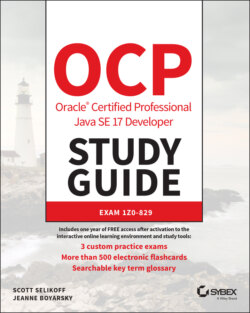Читать книгу OCP Oracle Certified Professional Java SE 17 Developer Study Guide - Jeanne Boyarsky - Страница 3
List of Tables
Оглавление1 IntroductionTABLE I.1 Exam information
2 Chapter 1TABLE 1.1 Setup procedure by operating systemTABLE 1.2 Important
javacoptionsTABLE 1.3 ImportantjavaoptionsTABLE 1.4 ImportantjaroptionsTABLE 1.5 Order for declaring a classTABLE 1.6 Primitive typesTABLE 1.7 Wrapper classesTABLE 1.8 Text block formattingTABLE 1.9 Reserved wordsTABLE 1.10 Tracking scope by block3 Chapter 2TABLE 2.1 Order of operator precedenceTABLE 2.2 Unary operatorsTABLE 2.3 Increment and decrement operatorsTABLE 2.4 Binary arithmetic operatorsTABLE 2.5 Simple assignment operatorTABLE 2.6 Compound assignment operatorsTABLE 2.7 Equality operatorsTABLE 2.8 Relational operatorsTABLE 2.9 Logical operatorsTABLE 2.10 Conditional operators
4 Chapter 3TABLE 3.1 Control statement usage
5 Chapter 4TABLE 4.1 Rules for
indent()andstripIndent()TABLE 4.2 Common formatting symbolsTABLE 4.3 Binary search rulesTABLE 4.4Arrays.compare()examplesTABLE 4.5 Equality vs. comparison vs. mismatchTABLE 4.6 Methods inLocalDate,LocalTime,LocalDateTime, andZonedDateTime...TABLE 4.7 Where to useDurationandPeriod6 Chapter 5TABLE 5.1 Parts of a method declaration in Figure 5.1TABLE 5.2 Optional specifiers for methodsTABLE 5.3 Optional specifiers for instance variablesTABLE 5.4 A method in ______ can access a ______ member.TABLE 5.5 Static vs. instance callsTABLE 5.6 The order that Java uses to choose the right overloaded method
7 Chapter 6TABLE 6.1 Class modifiers
8 Chapter 7TABLE 7.1 Interface member typesTABLE 7.2 Interface member accessTABLE 7.3 Usage of the
permitsclause in sealed classesTABLE 7.4 Modifiers in nested classesTABLE 7.5 Nested class access rules9 Chapter 8TABLE 8.1 Valid lambdas that return a
booleanTABLE 8.2 Invalid lambdas that should return abooleanTABLE 8.3 Method referencesTABLE 8.4 Common functional interfacesTABLE 8.5 Convenience methodsTABLE 8.6 Common functional interfaces for primitivesTABLE 8.7 Primitive-specific functional interfacesTABLE 8.8 Rules for accessing a variable from a lambda body inside a method...10 Chapter 9TABLE 9.1 Factory methods to create a
ListTABLE 9.2ListmethodsTABLE 9.3QueuemethodsTABLE 9.4DequemethodsTABLE 9.5 Using aDequeas a stackTABLE 9.6MapmethodsTABLE 9.7 Behavior of themerge()methodTABLE 9.8 Java Collections Framework typesTABLE 9.9 Collection attributesTABLE 9.10 Comparison ofComparableandComparatorTABLE 9.11 Helper static methods for building aComparatorTABLE 9.12 Helper default methods for building aComparatorTABLE 9.13 Types of boundsTABLE 9.14 Why we need a lower bound11 Chapter 10TABLE 10.1 Common
Optionalinstance methodsTABLE 10.2 Intermediate vs. terminal operationsTABLE 10.3 Creating a sourceTABLE 10.4 Terminal stream operationsTABLE 10.5 Common primitive stream methodsTABLE 10.6 Mapping methods between types of streamsTABLE 10.7 Function parameters when mapping between types of streamsTABLE 10.8 Optional types for primitivesTABLE 10.9SpliteratormethodsTABLE 10.10 Examples of grouping/partitioning collectors12 Chapter 11TABLE 11.1 Types of exceptions and errorsTABLE 11.2 Unchecked exceptionsTABLE 11.3 Checked exceptionsTABLE 11.4 ErrorsTABLE 11.5
DecimalFormatsymbolsTABLE 11.6 Common date/time symbolsTABLE 11.7 Supported date/time symbolsTABLE 11.8 Factory methods to get aNumberFormatTABLE 11.9 Factory methods to get aDateTimeFormatterTABLE 11.10Locale.CategoryvaluesTABLE 11.11 Picking a resource bundle for French/France with default locale ...TABLE 11.12 Selecting resource bundle properties13 Chapter 12TABLE 12.1 Options you need to know for using modules with
javacTABLE 12.2 Options you need to know for using modules withjavaTABLE 12.3 Access control with modulesTABLE 12.4 Reviewing servicesTABLE 12.5 Reviewing directivesTABLE 12.6 Common modulesTABLE 12.7 Java modules prefixed withjavaTABLE 12.8 Java modules prefixed withjdkTABLE 12.9 Modes usingjmodTABLE 12.10 Comparing command-line operationsTABLE 12.11 Options you need to know for the exam:javacTABLE 12.12 Options you need to know for the exam:javaTABLE 12.13 Options you need to know for the exam:jarTABLE 12.14 Options you need to know for the exam:jdepsTABLE 12.15 Options you need to know for the exam:jlinkTABLE 12.16 Practicing with automatic module namesTABLE 12.17 Properties of module typesTABLE 12.18 Comparing migration strategies14 Chapter 13TABLE 13.1
ExecutorServicemethodsTABLE 13.2FuturemethodsTABLE 13.3TimeUnitvaluesTABLE 13.4ScheduledExecutorServicemethodsTABLE 13.5Executorsfactory methodsTABLE 13.6 Atomic classesTABLE 13.7 Common atomic methodsTABLE 13.8LockmethodsTABLE 13.9 Concurrent collection classesTABLE 13.10 SynchronizedCollectionsmethods15 Chapter 14TABLE 14.1 File-system symbolsTABLE 14.2 Options for creating
FileandPathTABLE 14.3 CommonFileandPathoperationsTABLE 14.4 CommonFileandFilesoperationsTABLE 14.5 Common NIO.2 method argumentsTABLE 14.6PathAPIsTABLE 14.7 Thejava.ioabstract stream base classesTABLE 14.8 Thejava.ioconcrete I/O stream classesTABLE 14.9 Common I/O read and write methodsTABLE 14.10 CommonFilesNIO.2 read and write methodsTABLE 14.11 Common I/O stream methodsTABLE 14.12 The attributes and view typesTABLE 14.13 Walking a directory with a cycle using breadth-first searchTABLE 14.14 Key APIs16 Chapter 15TABLE 15.1 CRUD operationsTABLE 15.2 SQLTABLE 15.3 SQL runnable by the
executemethodTABLE 15.4 Return types ofexecutemethodsTABLE 15.5PreparedStatementmethodsTABLE 15.6ResultSet getmethodsTABLE 15.7 Sample stored proceduresTABLE 15.8 Stored procedure parameter typesTABLE 15.9ConnectionAPIs for transactions
